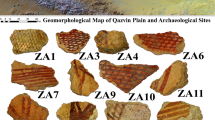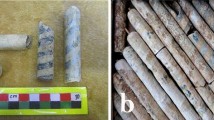Abstract
A comparative study of the composition and microstructure of two different brass alloys from reed pipes, one from a Spanish baroque organ and the other from a modern one, was carried out. This study allowed us to determine the procedure followed to produce the brass used to make ancient reed pipes. Moreover the distribution and correlation of lead and other trace elements present into the main component of the brass, the copper and zinc phases, of the historical tongues and shallots were established. This chemical composition was compared with that of a tongue from a twentieth-century organ. The whole study was accomplished using a combination of laboratory and synchrotron radiation techniques. X-ray fluorescence was the technique used to obtain elemental and chemical imaging of the main phases and the trace elements at a sub-micrometer scale.







Similar content being viewed by others
References
Herrera LK (2009) Physico-chemical research of cultural heritage materials using microanalytical methods. PhD Thesis, Ed. Seville University and Material Science Institute. Seville, ISBN 846920906-X
Justo-Estebaranz A, Herrera LK, Durán A, Sigüenza B, Jimenez de Haro MC, Laguna O, Justo A (2009) Análisis del proceso de restauración del órgano Cavaillé-Coll de la Iglesia de la Merced de Burgos. VI Congreso Internacional “Restaurar la memoria” ARPA (in press)
Manescu A, Fiori F, Giuliani A, Kardjilov N, Kasztovszky Z, Rustichelli F, Straumal B (2008) Non-destructive compositional analysis of historic organ reed pipes. J Phys Condens Matter 20:104250–104255
Baretzky B (2007) The metal sets the tone. Max Planck Research Focus 4:34–39
Guerra MF (2008) An overview on the ancient goldsmith’s skill and the circulation of gold in the past: the role of X-ray based techniques. X-Ray Spectrometry 37:317–327
Fikrle M, Frána J, Droberjar E (2006) Neutron activation and X-ray fluorescence analyses of Early Roman Age Bohemian artifacts. J Phys: Conference Series 41(1):267–274
Gianoncelli A, Kourousias G (2007) Limitations of portable XRF implementations in evaluating depth information: an archaeometric perspective. Appl Phys A 89:857–863
Dungworth D (1997) Roman copper alloys: analysis of artefacts from Northern Britain. JAS 24:901–910
Guerra MF (2008) Analysis of trace elements in gold alloys by SR-XRF at high energy at the BAMline. Nucl Instr and Meth in Phys Res B 266:2334–2338
Baretzky B, Friesel M, Straumal B (2007) Reconstruction of historical alloys for pipe organs brings true baroque music back to life. MRS Bulletin 32:249–265
Rehren T (1999) Small size, large scale Roman brass production in Germania inferior. JAS 26:1083–1087
Holleman AF, Wiberg E (2001) Inorganic chemistry. GmbH, Berlin
Lones TE (1919) Zinc and its alloys. Pitman, London
Duran A, Herrera LK, Jimenez de Haro MC, Justo A, Perez-Rodriguez JL (2008) Non-destructive analysis of cultural heritage artefacts from Andalusia, Spain, by X-ray diffraction with Göbel mirrors. Talanta 76:183–188
Somogyi A, Drakopoulos M, Vincze L, Vekemans B, Camerani C, Janssens K, Snigirev A, Adams F (2001) ID18F: A new micro-X-ray fluorescence end-station at the European Synchrotron Radiation Facility (ESRF): preliminary results. X-Ray Spectrom 30:242–252
Lengeler B, Schroer CG, Richwin M, Tümmler J, Drakopoulos M, Snigirev A, Snigireva I (1999) A microscope for hard X rays based on parabolic compound refractive lenses. Appl Phys Lett 74:3924–3926
Kocsis M, Somogyi A (2003) Miniature ionization chamber detector developed for X-ray microprobe measurements. J Synchrotron Rad 10:187–190
Martínez-Criado G, Somogyi A, Ramos S, Campo J, Tucoulou R, Salome M, Susini J, Hermann M, Eickhoff M, Stutzmann M (2005) Mn-rich clusters in GaN: hexagonal or cubic symmetry? Appl Phys Lett 86(13192):1–3
Solé VA, Papillon E, Cotte M, Walter Ph, Susini J (2007) A multiplatform code for the analysis of energy-dispersive X-ray fluorescence spectra. Spectrochimica Acta Part B 62:63–68
Baretzky B, Friesel M, Petelin A, Shotanov A, Straumal B (2006) Reconstruction of brass for tongues and shallots from baroque organs. Def Diff Forum 258–260:397–402
Baretzky B, Friesel M, Petelin A, Mazilkin Z, Straumal B (2006) Structure of historical brass tongues and shallots from baroque organs. Def Diff Forum 249:275–280
Ferrari AC, Robertson J (2000) Interpretation of Raman spectra of disordered and amorphous carbon. Phys Rev B 61:14095–14107
Acknowledgments
This work was supported by Ministry of Science and Technology of Spain (MAT 2007-63234) and Marie Curie Action MEST-CT2004-513915. The authors are very grateful to the company Gerhard Grenzing, S.A organ builders, for providing historical and modern tongues for our research, and to ESRF (ID 18F) for providing beamtime and for their assistance during our experiments.
Author information
Authors and Affiliations
Corresponding author
Rights and permissions
About this article
Cite this article
Herrera, L.K., Justo, A., Muñoz-Páez, A. et al. Study of metallic components of historical organ pipes using synchrotron radiation X-ray microfluorescence imaging and grazing incidence X-ray diffraction. Anal Bioanal Chem 395, 1969–1975 (2009). https://doi.org/10.1007/s00216-009-3075-3
Received:
Revised:
Accepted:
Published:
Issue Date:
DOI: https://doi.org/10.1007/s00216-009-3075-3




